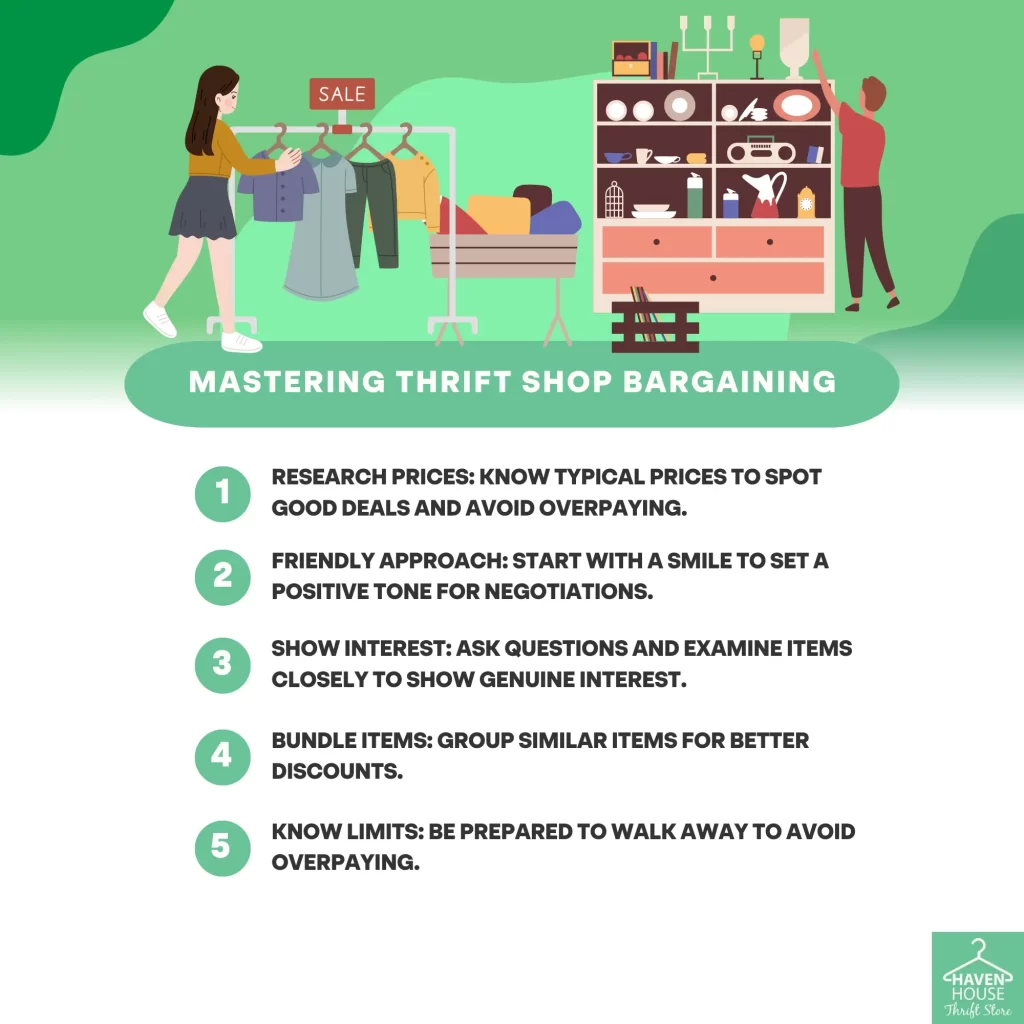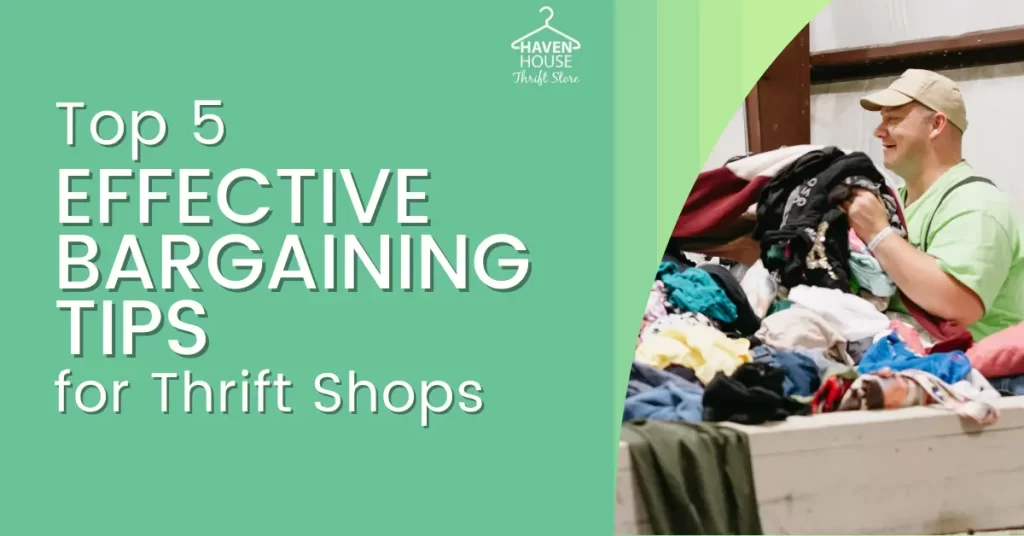To bargain effectively at thrift shops, start with some research to understand typical prices and store policies. Always approach staff with a smile; it sets a positive tone. Show genuine interest in items by asking questions and examining them closely. Consider bundling items for a better discount and don’t hesitate to point out imperfections. Finally, know when to walk away to avoid overpaying. If you master these strategies, you’ll improve your thrift shopping experience and make more informed purchases. There’s more to discover if you’re keen on sharpening your bargaining skills further.

Key Takeaways
- Research typical prices and brands to identify good deals and understand market value.
- Start with a friendly smile to set a positive tone and build rapport for negotiations.
- Show genuine interest by examining items closely and asking about their history.
- Bundle similar items to leverage better discounts and highlight imperfections to justify lower offers.
- Know when to walk away to avoid overpaying and ensure decisions align with your budget and item’s true value.
Research Before You Go
Before stepping into a thrift shop, take some time to research typical prices and brands so you can recognize a good deal when you see one. Knowing the market value of items helps you spot bargains and avoid overpaying. Familiarize yourself with popular brands and their quality, as this knowledge can greatly influence your purchasing decisions.
You might wonder, can you negotiate at Goodwill? While Goodwill stores generally have set prices, there’s no harm in asking. Approach the staff politely and inquire if they’re open to price adjustments, especially on items that have been on the shelf for a while or have minor defects. Your chances of success may vary, but it’s worth a try.
Researching before you go isn’t just about prices; it’s also about understanding the store’s policies. Some thrift shops have discount days or special sales events. Knowing these details can save you money and give you leverage when bargaining. Additionally, check online reviews for tips from other shoppers about which locations have the best deals and most flexible staff. Being well-prepared guarantees you make informed decisions and improves your overall thrift shopping experience.
Start With a Smile
Greeting the staff with a friendly smile sets a positive tone for your bargaining efforts. When you walk into a thrift shop with a warm demeanor, you’re likely to create a friendly atmosphere that makes negotiating easier. Staff members are more inclined to assist someone who treats them kindly. You might wonder, ‘Can you haggle at Goodwill or other similar stores?’ The answer is yes, but how you approach it matters.
Starting with a smile establishes rapport and signals that you’re not just looking for a deal but also value the interaction. This approach can make staff more willing to contemplate your offers. Remember, bargaining isn’t just about getting a lower price; it’s about mutual respect.
When you engage with the staff warmly, you’re setting the stage for a successful negotiation. They’ll be more open to listening to your reasons for asking for a discount, whether it’s a minor defect you’ve noticed or simply because you’re a loyal customer. By starting with a smile, you’re also demonstrating confidence and positivity, which can be contagious and create a more agreeable environment for both parties.
Show Genuine Interest
Demonstrating genuine interest in an item shows the staff that you’re serious about your potential purchase, which can make them more receptive to negotiating the price. When you’re browsing through items at a thrift shop, take the time to examine things closely. Ask questions about the item’s history or condition. This not only signals your interest but also provides you with valuable information that could be useful in your bargaining strategy.
If you’re wondering, ‘Can you haggle at Goodwill?’ the answer is often yes, but it’s essential to show that you’re genuinely considering the purchase. Staff are more likely to entertain price negotiations if they believe the item will find a good home. Compliment the item sincerely, discussing why it appeals to you or how it fits into your existing collection or wardrobe.
Bundle for Discounts
One effective way to maximize your savings at thrift shops is to bundle several items together and ask for a discount on the entire lot. Many thrift shops, including Goodwill, are open to negotiations, especially when you’re purchasing multiple items. This strategy works because it allows the seller to move more inventory while giving you a better deal. So, can you haggle at Goodwill? Absolutely, and bundling is a great way to start.
Here’s how you can make the most out of bundling:
- Group Similar Items: Select items that complement each other or belong to the same category. For instance, bundling a set of kitchen utensils or a collection of vintage records can catch the seller’s attention.
- Highlight Imperfections: Point out any flaws or wear and tear in the items. This can be a persuasive argument for a lower price when buying in bulk.
- Set a Reasonable Offer: Before approaching the seller, decide on a fair price for the entire bundle. Offer a slightly lower price than what you’re willing to pay to leave room for negotiation.
Know When to Walk Away
Knowing when to walk away is crucial in making certain you don’t overpay for items that aren’t worth the asking price. It’s easy to get caught up in the excitement of finding a unique piece, but if the price isn’t right, it’s time to step back. You might wonder, ‘Can you negotiate at Goodwill?’ While many thrift stores, including Goodwill, have set prices, there are always exceptions, especially for items with minor damage or missing parts.
Understanding your budget and the item’s true value will help you make informed decisions. If the store won’t budge on the price and it doesn’t fit your budget, walking away is the smart move. Sometimes, leaving empty-handed can feel disappointing, but it’s better than buyer’s remorse.
Conclusion
In your quest for thrift shop treasures, arm yourself with these unbeatable bargaining tips. Research like a detective, smile like you just won the lottery, and show interest like it’s the rarest gem on Earth. Bundle items as if you’re packaging gold, and know when to walk away like a savvy negotiator. Master these, and you’ll transform into the ultimate thrift shop hero, scoring deals no one else can even dream of. Go forth and conquer!

